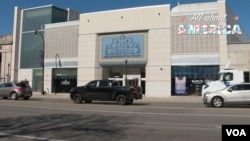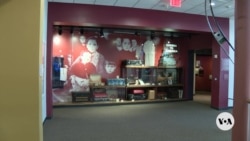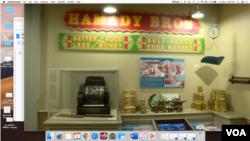All About America explores American culture, politics, trends, history, ideals and places of interest.
DEARBORN, MICHIGAN - The term slacks, meaning pants worn during relaxation activities, was coined by an Arab American. Joseph Haggar, a Lebanese immigrant, founded the iconic Haggar men’s clothing brand in 1926.
“He settled in Texas, and he started this pant company that was extremely successful in the 20th century,” says Diana Abouali, director of the Arab American National Museum in Dearborn, Michigan. “He also revolutionized the way that pants and clothing were mass produced.”
An exhibit at the museum is dedicated to Haggar, whose pants were worn by U.S. President Lyndon Johnson. Stories like Haggar’s are integral to the museum’s mission to demonstrate how Arab Americans have been part of the American fabric since the late 19th century.
“We communicate the American narrative in the voices of Arab Americans. They express their experiences in their own words,” Abouali says. “This provides people with a more authentic and real representation of what it means to be Arab American.”
The museum attempts to share the full range of the Arab American experience, including the journey to America, home and work life, and service in the U.S. Armed Forces.
The diverse offerings include an exhibit about the hundreds of Syrian and Lebanese immigrants who owned homesteads in North Dakota between 1890 and World War I. Thousands of descendants of those pioneers still live in North Dakota. Another exhibit includes lists of Arab American passengers on the doomed Titanic, which sank in 1912.
The museum also challenges religious misconceptions.
“Half of the Arab American community is Christian,” Abouali says. “And in fact, the earlier immigrants, who came in the late 19th century, early 20th century, were predominantly Christian.”
A wall of fame highlights prominent Arab Americans like journalist Helen Thomas, actress Kathy Najimy, politicians like former U.S. Secretary of Health and Human Services Donna Shalala, and Candace Lightner, who founded Mothers Against Drunk Driving in 1980.
Arab immigrant stories aren’t well-known among mainstream America. And what little Americans do know about Arabs is often informed by negative stereotypes.
“The obvious one would be the angry Arab, the terrorist Arab, the being afraid of the Arab that comes from abroad. I think that's the very obvious one, but it's a bit overplayed,” says Jasmine Hawamdeh, director of arts and culture at the American-Arab Anti-Discrimination Committee, a civil rights advocacy group. “And I think one of the more harmful stereotypes that currently exists in American media is the oppressed Arab woman.”
The museum tries to correct false narratives about Arab Americans.
“We're not always responding to misconceptions and narrative, although that's a major part of our work and a major sort of impetus for creating a museum like this,” Abouali says, “but also we're sort of presenting ourselves, as we are, unapologetically.”
Arab Americans are a diverse community that come from 22 Arab countries stretching from northern Africa to western Asia. But once they settle in the U.S., the museum director says, they become as American as they are Arab.










